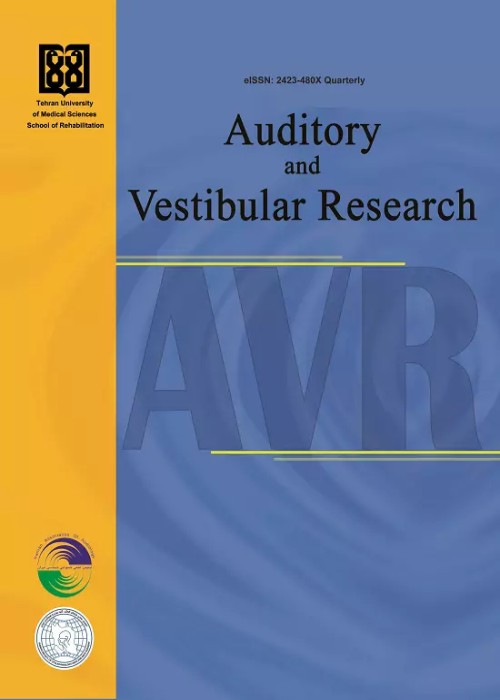Comparing Analog and Digital Hearing Aids in Reducing Hearing Disability
Author(s):
Abstract:
Objective
Comparing analog and digital hearing aids reducing disability caused by hearing deficiency among moderate to severe sensorineural hearing-impaired persons. Method and Material: This descriptive-analytic study was carried out on two groups of subjects participated in this study in some audiology clinics of hearing aid since May 2002 to October 2003. Twenty subjects wore analog hearing aids and twenty one subjects wore digital hearing aids. In this study, no subject had previous middle ear or psychological problems. APHAB questionnaire was completed before using hearing aid and 2 months after to determine benefit of hearing aid use. Results
Total score mean of APHAB inventory before and after use of analoge hearing aids were 52.215+6.420 and 32.300+3.443 respectively. Also total score mean of APHAB inventory before and after use of digital hearing aids were 54.9252+9.028 and 26.321+10.916 respectively. There was no significant difference between total mean score of APHAB inventory before and after using analog and digital hearing aids (P=0.058).While there was significant difference between total mean score of APHAB questionnaire before and after use of analog hearing aids (P<0.001) and also before and after use of digital hearing aids (P<0.001). Moreover age, gender, litracy level, occupation, degree of hearing loss and manner of hearing aid usage did not have significant effect on APHAB results. Configuration of loss had siginficant effect on aversiveness subscale before and after use of analog hearing aids (P=0.008). Previous experience and duration of hearing aid usage had significant effect on aversiveness subscale before and after use of digital hearing aids (P=0.043) and (P=0.024), respectively, while all of these three items did not have significant effect on total mean score of APHAB inventory and also total mean scores of three subscales of ease of communication, reverberation and background noise. Conclusion
Comparing to analog hearing aid, digital one is significantly benefitial for reverberation and background noise for hearing-impaired persons, but it has no benefit for ease of communication and aversiveness that may be arised from effects of the individual expectation, psychological and personal factors.Language:
Persian
Published:
Auditory and Vestibular Research, Volume:13 Issue: 1, 2004
Page:
3
magiran.com/p510420
دانلود و مطالعه متن این مقاله با یکی از روشهای زیر امکان پذیر است:
اشتراک شخصی
با عضویت و پرداخت آنلاین حق اشتراک یکساله به مبلغ 1,390,000ريال میتوانید 70 عنوان مطلب دانلود کنید!
اشتراک سازمانی
به کتابخانه دانشگاه یا محل کار خود پیشنهاد کنید تا اشتراک سازمانی این پایگاه را برای دسترسی نامحدود همه کاربران به متن مطالب تهیه نمایند!
توجه!
- حق عضویت دریافتی صرف حمایت از نشریات عضو و نگهداری، تکمیل و توسعه مگیران میشود.
- پرداخت حق اشتراک و دانلود مقالات اجازه بازنشر آن در سایر رسانههای چاپی و دیجیتال را به کاربر نمیدهد.
In order to view content subscription is required
Personal subscription
Subscribe magiran.com for 70 € euros via PayPal and download 70 articles during a year.
Organization subscription
Please contact us to subscribe your university or library for unlimited access!


